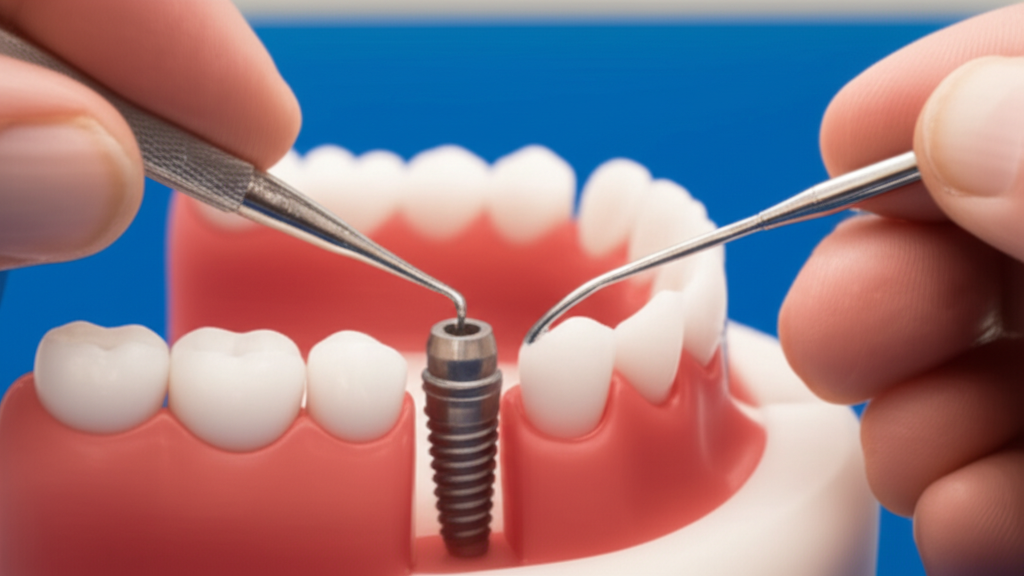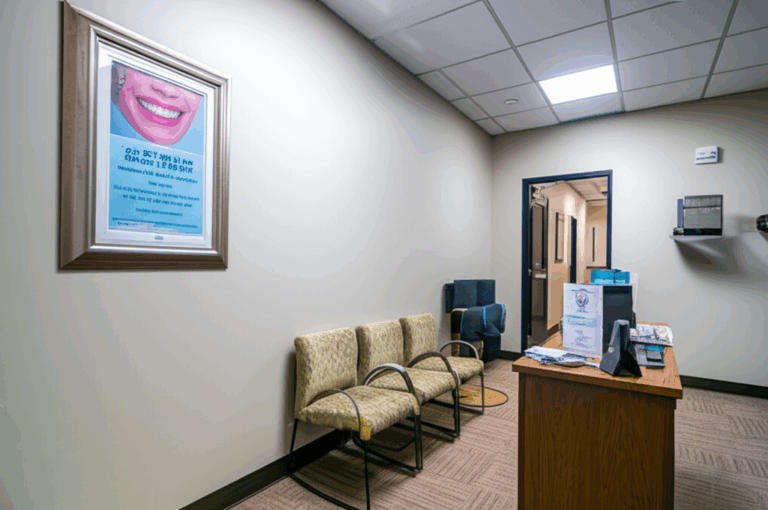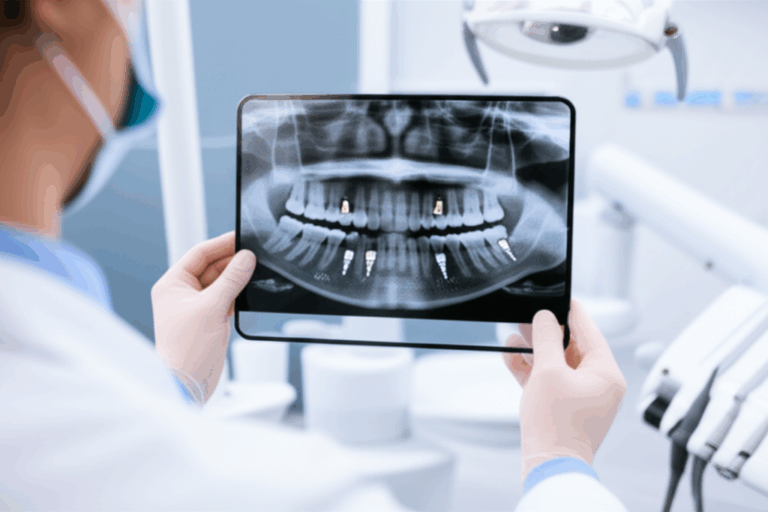
How to Fix a Loose Dental Implant: Your Urgent Guide to Causes, Solutions, and When to See a Dentist
That scary wiggle. That odd feeling in your mouth. A dental implant that moves a little or feels loose can be worrying for anyone. If you’re reading this, you might be thinking, “Is my dental implant loose? Is this an emergency? What am I supposed to do?” First—take a deep breath. You are not alone, and you’re in the right place.
Dental implants are supposed to be a steady, long-lasting solution for missing teeth, so feeling one move is not normal. The good news? A loose dental implant doesn’t always mean disaster. With the right ideas and quick action, many problems can be fixed—sometimes easier than you think.
In this guide, I’ll explain why dental implants sometimes come loose, how you can spot the problem, what to do right away, and when you need to see a dentist. Think of me as your straightforward, helpful dental guide, here to show you each step in plain words.
In This Article
What We’ll Cover:
- What Does a Loose Dental Implant Really Mean?
- Diagnosing the Problem: Loose Crown, Abutment, or Implant?
- The Most Common Causes of Implant Loosening
- First Aid: What You Should (and Shouldn’t) Do Right Now
- How Your Dentist Will Figure Out What’s Wrong
- Professional Solutions: Fixes for Every Type of Looseness
- How to Keep Your Implant Secure for Years to Come
- When to Call the Dentist—Fast
- Your Next Steps for a Confident Smile
What Does a Loose Dental Implant Really Mean?
Let’s be honest: dental implants should feel like real teeth. They don’t move at all. So, if you notice your implant feels shaky, it’s your mouth’s way of saying, “Hey, something needs checking.”
Why does this matter? Because a loose dental implant is not just a small problem. It’s your sign to act fast, before a small issue turns into a big one—sometimes costing you more money, time, and pain.
But don’t worry too much. Looseness can mean anything from a simple, quick repair to a sign of something more serious. I’m here to help you figure out which it is.
Diagnosing the Problem: Loose Crown, Loose Abutment, or Implant?
The first thing to do? Find out what’s moving. Not every loose feeling means your whole implant is in trouble.
What’s Moving? A Simple Checklist
1. Is it just the crown?
- Feels like: The top part (your fake tooth) moves, but the rest feels steady.
- Causes: Could be the dental glue coming loose or the crown screw getting wobbly.
- How bad is it? Usually, this is a fast fix at the dentist.
2. Is it the abutment?
- Feels like: The “connector” between the implant post and the crown is loose, but the metal post in your bone feels solid.
- Causes: Usually the abutment screw is loose.
- How bad is it? Needs a dentist, but often easy to repair at the office.
3. Is the whole implant post moving?
- Feels like: The whole metal post under your gum and in your bone moves, especially if you push or bite down.
- Causes: This is more serious. It could mean bone loss, an infection, or that the implant never stuck well to your jawbone.
- How bad is it? Needs quick dental care—sometimes the implant must be taken out and replaced later.
Quick tip: Try not to poke or push the area too much. But noticing what feels loose will help your dentist know what’s going on faster.
The Most Common Causes of Implant Loosening
Let’s look at why this happens. Think of your implant like a tiny building project in your mouth—posts, screws, and connectors all need to be tight and healthy. Sometimes a piece lets go, or the base (your bone and gum) gets weak.
Mechanical Issues: The Hardware Gets Loose
- Loose or broken abutment screw: Like a small bolt on a chair, if this gets loose, things start to move.
- Broken cement: The glue holding your crown can wear out with time.
- Cracked abutment or implant pieces: Not common, but sometimes the connector breaks—especially if you bite too hard or grind your teeth.
- Broken screws or worn threads: Over years, screws can strip or snap.
Biological Issues: Trouble With Your Gums or Bone
- Peri-implantitis: This is like gum disease, but around an implant instead of a tooth. Germs move in, making your bone shrink away from the metal. You might notice red, swollen gums, pus, bleeding, and pain.
- Failed osseointegration: If the implant never really fused to your bone, or if the bond breaks later, the whole thing can move.
- Jawbone shrinking: If you lose bone around the spot, it can weaken the implant.
- Biting hard or grinding at night: Biting too hard or clenching your teeth puts pressure on the implant. Over time, that can make parts work their way loose.
- Injury: Getting hit in the mouth or chewing really hard foods can mess up your implant.
- Smoking and health problems: Smoking makes trouble with implants more likely. Badly controlled diabetes or untreated gum disease also play a role.
Fun fact: Studies say about 10-15% of single crowns on implants get loose screws in 5-10 years, but most are easy to fix!
First Aid: What You Should (and Shouldn’t) Do Right Now
If your implant or crown feels loose, don’t panic. Just follow these simple, dentist-approved steps to avoid making things worse:
Your Dental “First Aid” Checklist
1. DON’T try to fix it yourself.
Those tiny screws and crowns need special tools—DIY can make things worse or break your implant.
2. DON’T chew on that side.
Use the other side for chewing, and eat soft foods if you can.
3. Keep it clean—but gently.
Brush softly with a soft-bristled toothbrush, and rinse your mouth with warm saltwater (just a teaspoon of salt in a glass of water). Skip harsh mouthwashes that burn or dry your mouth.
4. Save any loose pieces.
If the crown or screw falls out, keep it in a clean bag or container. Bring it with you to the dentist—the part might be reusable and save you money.
5. Book an appointment with your dentist right away.
Even if you don’t have much pain, get seen soon. The quicker you act, the simpler the fix.
Avoid These Common Mistakes
- Don’t try to glue any part back in at home!
- Don’t wiggle or push the implant to see how bad it is—it can make it worse.
- Don’t skip your dentist appointment hoping it’ll fix itself. Looseness almost never “goes away” on its own.
How Your Dentist Will Figure Out What’s Wrong (Diagnosis Process)
You might wonder, “What will my dentist actually do?” Here’s how they’ll check things out. Getting the right problem means getting the right fix.
Step-by-Step: At the Dental Office
1. Check your mouth:
Your dentist will look closely, gently press the area, and ask about any pain, swelling, or infection.
2. See what moves:
Is it just the crown, the abutment, or is the whole post wiggling? They’ll check gently.
3. Take X-rays or scans:
Pictures let them see if there’s bone loss, infection, or a broken part under your gums. Think of it like checking your mouth’s “blueprint.”
4. Measure your gums:
They might check for deep gum pockets or infection around the implant.
5. Go over your health and dental history:
Things like uncontrolled diabetes, osteoporosis, or past bone problems help fill in the picture.
Pro Tip
Sometimes, your dentist may send you to a specialist for tougher repairs or for lab-made parts.
Professional Solutions: Fixes for Every Type of Looseness
Every kind of looseness has its own fix—think simple part repairs or fixing your jawbone’s health.
When It’s a Mechanical Problem: Crowns, Abutments & Screws
- Loose crown:
Your dentist can remove the crown and glue it back, or tighten (maybe replace) the small screw holding it.
- Loose abutment:
With special tools, they can tighten or swap out the abutment screw. Sometimes, the abutment needs replacing if it’s wrecked.
- Broken screws or connectors:
Broken screws need careful removal and replacement—definitely a dentist’s job.
Good news: These repairs are often fast and most people feel no pain—just relief!
When It’s a Gum or Bone Problem: Infection, Bone Loss & Osseointegration
- Early gum infections (peri-implantitis):
Careful cleaning, maybe with gentle lasers or rinses, can wipe out germs. Your dentist might give you antibiotics.
- Medium or severe bone loss:
If bone is missing, you may need deep cleaning and maybe a bone graft to help grow back bone. Followed by antibiotics and checkups.
- Failed osseointegration (the implant never sticks):
Sadly, if the implant never locked to your bone or comes loose well after healing, it probably needs to come out. But don’t lose hope—after healing, most people can get a new implant, a bridge, or sometimes a removable denture.
If your implant must come out:
- Numbing the area (so you won’t feel pain).
- The implant is removed very carefully.
- You’ll wait a few months to heal before getting a new tooth, bridge, or denture.
Preventing More Problems
Your dentist will try to stop this from happening again:
- Nightguards for people who grind their teeth.
- Help to quit smoking.
- Tips to control diabetes or other health issues.
- Adjusting your bite so no teeth have too much pressure.
How to Keep Your Implant Secure for Years to Come
Putting a little effort in every day will help your implant—and your smile—stay strong for a long time.
Easy Everyday Tips:
- Brush gently but well, twice a day, with a soft toothbrush. Clean around your gumline and implant.
- Floss, or use small brushes, to clean between teeth and around the implant.
- Use germ-killing mouthwash if your dentist suggests it.
- Get professional cleanings every 3-6 months. Dental tools can reach spots you can’t get to at home.
More Tips For Long-Lasting Implants
- Wear a nightguard if you grind at night—these are special mouthpieces made by your dentist.
- Skip chewing ice, super-hard candy, or other really tough foods near your implant.
- Don’t smoke—it makes problems more likely.
- Tell your dentist if you notice looseness, pain, or anything weird, right away.
Fast Fact: Dental implants work for 95-98% of healthy people for more than 10 years. Most problems can be avoided with simple care!
If you want more info on daily tooth care, check out this detailed guide on teeth health.
When to Call the Dentist—Fast
Waiting even a day or two can turn a fixable problem into a real emergency. Get help fast if:
- You have strong or throbbing pain.
- There’s pus, swelling, or red gums around the implant.
- You feel feverish or sick.
- You can’t eat, speak, or swallow because of the pain.
- The crown, abutment, or the whole implant post falls out.
Better safe than sorry: Infections or failed implants are much easier and cheaper to fix quickly. Don’t try to handle it alone.
Your Next Steps for a Confident Smile
Let’s keep it easy:
1. Don’t panic, but don’t ignore it.
A loose implant is not normal, but can often be saved if you act quickly.
2. Don’t chew on the loose area.
Eat soft foods and use the other side of your mouth.
3. Keep things clean, but don’t try to fix it yourself.
Brush gently and rinse with saltwater.
4. See your dentist soon.
The sooner you go, the easier and cheaper it will probably be.
5. Make a long-term plan with your dentist.
Fix biting and grinding issues, stay healthy, and get regular checkups.
FAQs About Loose Dental Implants
Is a loose dental implant an emergency?
It can be—especially if the post is moving, or you have pain or infection. Even small looseness should be checked soon.
Can you tighten a dental implant yourself?
No. Special tools and know-how are needed. Trying to fix it at home can make things much worse.
How much does it cost to fix a loose implant?
If it’s just a crown or abutment, it’s usually not expensive. If you need infection treatment or a totally new implant, it costs more. Many dentists have payment plans or work with insurance.
How long do dental implants last?
With the right care, many years! Most healthy people enjoy their implants for at least 10 years.
For Those Considering Implants, or Facing Looseness
Not everyone is a good candidate for implants. You need enough bone, healthy gums, and well-controlled health conditions (like diabetes). People with untreated gum disease, heavy smoking, or a lot of missing bone may need other treatments—or another solution like a bridge or removable dentures instead. The best advice always comes from a full checkup with your dentist.
Your Takeaway: Prevention and Fast Care Matter Most
Let’s quickly go over the most important things:
- A loose implant is not normal, but fast action can save it.
- Act quickly. Gentle cleaning and a dental visit right away make all the difference.
- Prevention works. Brush, floss, visit your dentist, and stay healthy to keep your implant going strong.
Ready for your next step?
If you see movement, feel pain, or something changes with your implant, call your dentist now. You’ll get fast, helpful answers and the care you need.
Dental implants can really change your life for the better—eating apples, laughing with friends, and enjoying a full smile. Don’t let a small loose screw or a little worry get in your way. Take care of it, stay smart, and keep smiling!
For more help with dental care and solving everyday tooth worries, check out our guides on teeth information and dental care.
Sources:
- American Dental Association (ADA)
- American Academy of Implant Dentistry
- Top dental health studies on implant success and problems
(This article is for information only. It’s not a replacement for advice from a licensed dentist. If you’re not sure, always talk to your dentist or oral surgeon directly.)








